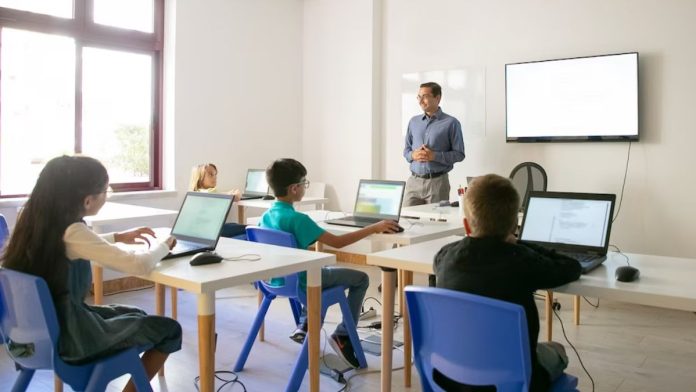
When we think of the classroom, the images that first come to mind are teachers, blackboards, chalk, and dusters. However, today, technology has outdone these expectations of the classroom environment, bringing the concept of “smart classrooms.”
As we witnessed during this pandemic, educational standards, advancements, and innovations saw a noticeable upsurge.
Schools and other educational institutions have adopted modern teaching techniques using virtual whiteboards, projectors, and audio/visual components that make learning enjoyable for their students while helping teachers deliver instruction effectively. All these components together form what’s known as a smart class environment – fun learning experiences with engaging lessons for both pupils and instructors!
Smart classroom equipped with interactive whiteboards, digital projectors, and other cutting-edge technologies have become an increasing norm across schools worldwide. Smart classrooms bring many benefits that enhance students’ and educators’ educational experience.
Contents
- 1 What Is The Concept Of Smart Classrooms?
- 2 Benefits Of Smart Classrooms
- 2.1 1. Interactive Learning
- 2.2 2. Unlock Access to Resources and Solutions
- 2.3 3. Custom Designed Learning Paths (PLPs)
- 2.4 4. Real-Time Collaboration
- 2.5 5. Increased Engagement and Motivation
- 2.6 6. Increase Teacher Efficiency
- 2.7 7. Sustainability and Cost-Effectiveness
- 2.8 8. Seamless Communication
- 2.9 9. Effective Learning
- 2.10 10. Prepare Students For Success In Their Future
- 3 Conclusion
What Is The Concept Of Smart Classrooms?
Smart classroom are equipped with technology to facilitate teaching and learning by using resources like computers, specialised software applications, audience response devices, assistive listening devices, networking connections, and audio/visual capabilities. The majority of schools in Jaipur and throughout the nation are bringing digital smart classrooms to help students with better learning.
And why not? The benefits such classrooms offer are immense. Here, we will check why schools are adopting such classrooms and the benefits.
Benefits Of Smart Classrooms
1. Interactive Learning
Smart classroom foster interactive learning environments, moving away from traditional one-way communication models. Interactive whiteboards enable teachers to use engaging presentations, annotate real-time content, and encourage student participation. Hence, this approach captures students’ attention and encourages active engagement within the educational process.
2. Unlock Access to Resources and Solutions
Smart classrooms transform the entire world into the classroom. Leveraging the internet as an endless source of knowledge, smart classrooms provide their students with access to many educational resources ranging from virtual field trips and online research papers, helping expand perspectives while deepening understanding.
3. Custom Designed Learning Paths (PLPs)
Smart classrooms recognize this, utilising technology to customise learning paths to meet each student’s diverse learning styles and individual needs. Through adaptive learning platforms, these personalised strategies maximise education’s efficiency while ensuring no student falls through the cracks.
4. Real-Time Collaboration
Smart classrooms facilitate real-time collaboration among students and instructors via cloud-based tools and collaborative platforms. Hence, this facilitates group projects, discussions, document editing, and shared document creation. Hence, this not only improves teamwork skills but also equips them for modern workplace collaborations.
Further, teachers or instructors can offer instantaneous feedback while tracking each student’s progress – creating an exciting, dynamic, and immersive learning environment.
5. Increased Engagement and Motivation
Technology can hold students’ interest, which smart classrooms utilise by including multimedia elements, educational games, and simulations in the learning experience. This makes learning more enjoyable and can increase engagement and motivation – turning tedious tasks into exciting challenges that foster positive attitudes toward education.
6. Increase Teacher Efficiency
The advantages of smart classrooms are immense for both the students and educators alike. Automating administrative tasks, like grading and attendance tracking, frees educators to spend more time teaching directly while engaging students in interactions and creating learning outcomes that benefit all.
Moreover, smart classrooms also give teachers insight into student performance analytics to fine-tune teaching strategies accordingly for greater results.
7. Sustainability and Cost-Effectiveness
Digital teaching materials provide more eco-friendly teaching practices by cutting down on paper usage. Smart classrooms eliminate printed textbooks, preventing trees from being cut down while decreasing carbon emissions from educational institutions. While initial setup costs might seem intimidating at first, smart classroom prove to be an investment worth making in terms of decreased paper consumption and energy savings compared to more conventional teaching approaches.
8. Seamless Communication
Smart classrooms make communication between educators, students, and parents much smoother by employing digital platforms and communication tools that facilitate instantaneous dialogue among all parties involved about assignments, schedules, and student progress reports – this helps enhance overall educational experiences while strengthening partnerships between educators and parents in supporting student learning.
9. Effective Learning
Psychologists consider visual learning using smart technology elements such as images, graphs, flow charts, and videos highly effective and help students grasp concepts quickly. Smart classroom reduce distractions so students can concentrate more and retain more information.
10. Prepare Students For Success In Their Future
Smart classrooms equip students to become future-ready. Digital learning strategies focus heavily on methods that foster productive collaboration while drawing their attention toward an interactive teaching methodology.
Presentation skills, learning to differentiate between reliable and questionable sources on the internet, adhering to proper online etiquette practices, and many other practical abilities can all be acquired using digital resources. Early exposure can prepare children for future digital demands.
Conclusion
Smart classrooms represent more than simply technological upgrades; they represent a fundamental shift in how we perceive education. Their benefits go beyond mere convenience: smart classroom create opportunities for engaging, personalised, and sustainable learning experiences.
